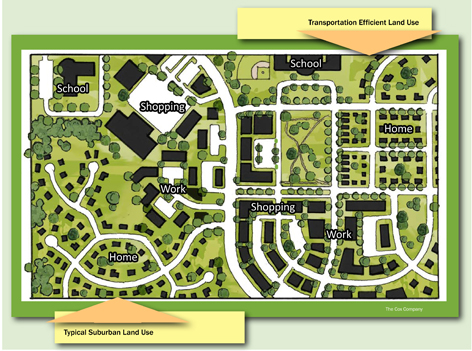Transportation Efficient Land Use and Design Guide
 Roads are a critical public resource and constitute a major investment of the public’s money.
Roads are a critical public resource and constitute a major investment of the public’s money.
To maximize this investment, cost effective approaches to how we design, build and pay for our roads and transportation systems need to be considered.
One such approach involves transportation-efficient land use and design. Drawing on the features of our historic towns and villages, it offers an alternative to conventional suburban development, by emphasizing such features as:
- Compact and walkable development patterns
- Mixing of land uses
- Interconnected networks of streets and blocks
- Neighborhood centers
- Accessible open spaces
Transportation Benefits
Residents travel less often, travel shorter distances when they do, and have greater opportunities to travel by foot, bicycle, or transit.
The result is reduced costs for right of way, road widening, secondary street maintenance and travel for commuters.
Land Development And Infrastructure Benefits
Higher density mixed-use communities require less road building and maintenance, fewer miles of utility systems, and reduced distances for school bus routes and emergency service delivery.
Local Fiscal And Housing Market Benefits
 Growing market preference produces better project sales and higher assessment valuations. The housing consumer gains expanded housing choice in terms of type, ownership vs. rental, and cost.
Growing market preference produces better project sales and higher assessment valuations. The housing consumer gains expanded housing choice in terms of type, ownership vs. rental, and cost.
Guide
The Transportation Efficient Land Use and Design Guide offers information on principles and design best practices, the benefits of such design, planning for transportation efficient growth, methods for engaging the public in the planning process, and implementation strategies.
Transportation Efficient Land Use and Design – A Guide (PDF 19MB) 
Examples of planning for such development, transportation benefit studies, implementation ordinances, and community opinion surveys are presented in The Appendices below.
Appendices:Transportation Efficient Land Use and Design (PDF 3MB) 
Presentation: Overview of Transportation Efficient Land Use and Design (PDF 11MB) 
Implementing Transportation Efficient Development
The Virginia Department of Rail and Public Transportation (DRPT) developed Multimodal System Design Guidelines, which utilize the same concepts highlighted in the Transportation Efficient Land Use and Design Guide, and provide a roadmap for the incorporation of these concepts into activity center (higher density mixed-use development) design.
Multimodal System Design Guidelines
The Virginia Department of Transportation has adopted DRPT’s Guidelines as alternate street design standards that may be adopted by localities for the construction of streets within activity centers. Supplemental material for the adoption of these Guidelines as alternate standards by localities is contained in Appendix B(2) of VDOT’s Road Design Manual.
Transportation efficient development depends upon the integration of various modes of travel with their surrounding land uses. Such integration sometimes results in the use of amenities not normally found on state highways. This document summarizes the rules and regulations that apply to the use of such amenities.



